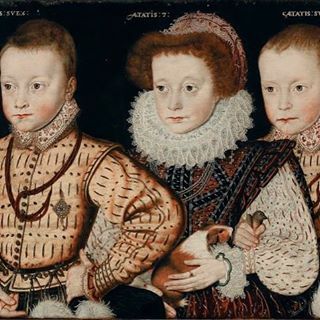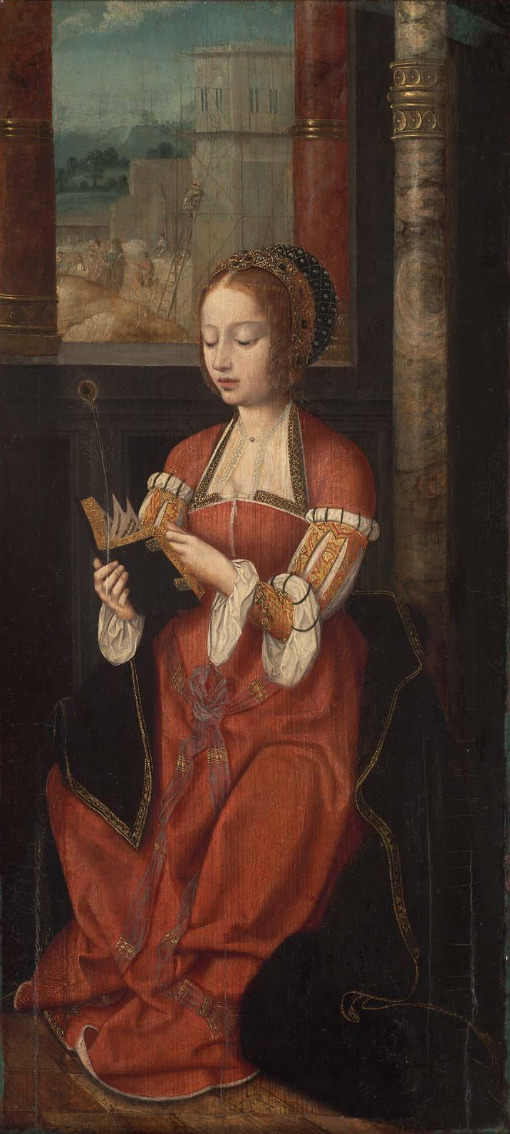#Unidentified Netherlandish artist
Video
Unidentified Netherlandish artist, Christ Carrying the Cross, ca. 1510-1520, Oil on wood panel, 11/21/23 #legionofhonor by Sharon Mollerus
#fine art#Legion of Honor Museum#Oil on wood panel#Christ Carrying the Cross#ca. 1510-1520#Unidentified Netherlandish artist#San Francisco#CA#flickr
0 notes
Photo

Portrait of a Man, c. 1480-1500, Cleveland Museum of Art: Medieval Art
Although the subject of this portrait wears rich clothing and a sword, nothing specifically associates him with aristocracy. Instead he may have been a wealthy member of the middle class. During the 1400s, portraiture became increasingly popular with prosperous merchants and tradesmen who imitated the portraits commissioned by the dukes of Burgundy and members of their court. The artist is equally mysterious and unidentified. The highly refined technique of oil painting suggests a familiarity with Netherlandish art, and the dark palette and clothing allude to Burgundian portraiture. However, the clothing and facial type relate more to French traditions. The artist may have hailed from France or the Low Countries, a region with a long artistic association with the Valois dukes of Burgundy who ruled the Netherlands in the late 1300s and 1400s.
Size: Framed: 52.5 x 38 x 5 cm (20 11/16 x 14 15/16 x 1 15/16 in.); Unframed: 42.5 x 27.6 cm (16 3/4 x 10 7/8 in.)
Medium: oil on wood
https://clevelandart.org/art/1963.503
26 notes
·
View notes
Photo

The Magdalen Weeping (c 1525) is an oil on oak panel painting attributed to the workshop of the unidentified Early Netherlandish artist known today by the notname the Master of the Legend of the Magdalen, active in Brussels.
152 notes
·
View notes
Photo

Master of the Mansi Magdalene - Salvator Mundi in a Landscape -
Salvator Mundi, Latin for Saviour of the World, is a subject in iconography depicting Christ with his right hand raised in blessing and his left hand holding an orb (frequently surmounted by a cross), known as a globus cruciger. The latter symbolizes the Earth, and the whole composition has strong eschatological undertones.
The theme was made popular by Northern painters such as Jan van Eyck, Hans Memling, and Albrecht Dürer. There are also several versions of the theme attributed to Titian, notably the one in the Hermitage Museum.
One painting of the subject, simply titled Salvator Mundi, was attributed or reattributed to Leonardo da Vinci in 2011. This painting disappeared from 1763 until 1900, when it was acquired from Sir Charles Robinson. It was at the time thought to be a work by Leonardo's follower, Bernardino Luini, and was purchased for the Doughty House in Richmond, London by Sir Francis Cook . By this time Christ's face and hair had been extensively repainted. A photograph taken in 1912 records the work's altered appearance. In 2017, this painting sold at auction for US$450,300,000, the highest price ever paid for a painting.
The Master of the Mansi Magdalen (c.1490 – 1530), was an Early Netherlandish painter.
In art history, a Notname, "necessity-name" or "contingency-name") is an invented name given to an artist whose identity has been lost. The practice arose from the need to give such artists and their typically untitled, or generically titled works, an acceptable if unsatisfactory grouping, avoiding confusion when cataloging. The phrases provisional name, name of convenience and emergency names are sometimes used to describe anonymous masters; nonce name was at one time used.
The practice of using generic names for unidentified artists is most common in the study of art of the antiquity, especially of the Roman era or with artists of the Northern Renaissance until about 1430. Typically a pseudonym is applied after commonality is established for a grouping of works, of which a similarity of theme, style, iconography, biblical source or physical location can probably be attributed to one individual or workshop, but because of lack of surviving documentary record, the name of that individual is lost. Groupings of works under a given notname can often be contentious; in specific cases art historians have argued that the reality may be a group or school of artists working under a common influence or commercial demand. Linking a generically titled old master with a historical person is usually a tempting and exciting prospect, and would establish an art historian's reputation.
37 notes
·
View notes
Photo


Saint Barbara (unidentified artist, Netherlandish, 16th century).
Oil on panel.
Images and text information courtesy MFA Boston.
70 notes
·
View notes
Photo

Saint Barbara (detail)
Unidentified artist, Netherlandish, 16th century
62 notes
·
View notes
Text
African Magi with BEAUTIFUL outfit- spotted at Harvard Art Museum
avoyagetoarcturus submitted:
The Adoration of the Magi, in the Harvard Art Museum in Cambridge, Massachusetts.
Sign reads:
Master of 1518
Netherlandish, active early 16th century
The Adoration of the Magi; left panel: The Nativity; right panel: The Presentation in the Temple, c. 1520
Oil on panel
Fogg museum, Anonymous gift in honor of Seymour Slive, 1991.146
The unidentified master’s name derives from the date on an altarpiece in a church in Lübeck, Germany. He belonged to a group of artists, active in Antwerp from about 1510 to 1530, whose paintings are characterized by attenuated figures striking mannered poses in brightly colored costumes, and the grafting of Italian Renaissance ornament onto the medieval architecture that often serves as a backdrop. Rather than working on commission, some Antwerp workshops produced ready-made altarpieces depicting standard subjects suitable for ecclesiastical settings that did not require specific iconographic programs. The work on display here belongs to this type and retains the original, plain molding that frames other examples. Many of these retables (altarpieces) were exported through Antwerp trading channels as far as northern Germany, Poland, Spain, and Portugal.
230 notes
·
View notes
Photo

Jan van Eyck part 2 Along with Robert Campin and later Rogier van der Weyden, Van Eyck revolutionised the approach towards naturalism and realism in Northern European painting during the early to mid 15th century. He was the first to manipulate oils to give the close detailing that infused his figures with the high degree of realism and complexity of emotion seen in this diptych. He coupled this with a mastery of glaze to create luminous surfaces with a deep perspective—most noticeable in the upper portion of the Crucifixion panel—which had not been achieved before. Van Eyck was highly influential and his techniques and style were adopted and refined by the Early Netherlandish painters. The Crucifixion and Last Judgement diptych (or Diptych with Calvary and Last Judgement) consists of two small painted panels attributed to the Early Netherlandish artist Jan van Eyck, with areas finished by unidentified followers or members of his workshop. This diptych is one of the early Northern Renaissance oil on panel masterpieces, renowned for its unusually complex and highly detailed iconography, and for the technical skill evident in its completion. It was executed in a miniature format; the panels are just 22.2 in high by 7.8 in wide. The diptych was probably commissioned for private devotion. #destroytheday
0 notes
Photo

Three unidentified Elizabethan children by an unknown Anglo-Netherlandish artist, c. 1580. To celebrate our latest call for papers on #earlymodern #animals (see website link in bio), we have included a painting that the National Portrait Gallery believes to be the first depiction of a pet Guinea pig! The little girl is cradling the exotic critter, whilst the boy on the right clutches a small bird, a much more common pet amongst children at that time. 🐁🐹🐤🕊 #art #artist #arthistory #painting #portrait #animal #pet #guineapig #renaissanceart #renaissance
#arthistory#painting#pet#art#artist#portrait#animals#renaissance#earlymodern#guineapig#renaissanceart#animal
0 notes
Photo

Portrait of a Man, c. 1480-1500, Cleveland Museum of Art: Medieval Art
Although the subject of this portrait wears rich clothing and a sword, nothing specifically associates him with aristocracy. Instead he may have been a wealthy member of the middle class. During the 1400s, portraiture became increasingly popular with prosperous merchants and tradesmen who imitated the portraits commissioned by the dukes of Burgundy and members of their court. The artist is equally mysterious and unidentified. The highly refined technique of oil painting suggests a familiarity with Netherlandish art, and the dark palette and clothing allude to Burgundian portraiture. However, the clothing and facial type relate more to French traditions. The artist may have hailed from France or the Low Countries, a region with a long artistic association with the Valois dukes of Burgundy who ruled the Netherlands in the late 1300s and 1400s.
Size: Framed: 52.5 x 38 x 5 cm (20 11/16 x 14 15/16 x 1 15/16 in.); Unframed: 42.5 x 27.6 cm (16 3/4 x 10 7/8 in.)
Medium: oil on wood
https://clevelandart.org/art/1963.503
8 notes
·
View notes
Photo

Portrait of a Man, c. 1480-1500, Cleveland Museum of Art: Medieval Art
Although the subject of this portrait wears rich clothing and a sword, nothing specifically associates him with aristocracy. Instead he may have been a wealthy member of the middle class. During the 1400s, portraiture became increasingly popular with prosperous merchants and tradesmen who imitated the portraits commissioned by the dukes of Burgundy and members of their court. The artist is equally mysterious and unidentified. The highly refined technique of oil painting suggests a familiarity with Netherlandish art, and the dark palette and clothing allude to Burgundian portraiture. However, the clothing and facial type relate more to French traditions. The artist may have hailed from France or the Low Countries, a region with a long artistic association with the Valois dukes of Burgundy who ruled the Netherlands in the late 1300s and 1400s.
Size: Framed: 52.5 x 38 x 5 cm (20 11/16 x 14 15/16 x 1 15/16 in.); Unframed: 42.5 x 27.6 cm (16 3/4 x 10 7/8 in.)
Medium: oil on wood
https://clevelandart.org/art/1963.503
11 notes
·
View notes
Photo

Saint Barbara
Unidentified artist, Netherlandish, 16th century
12 notes
·
View notes
